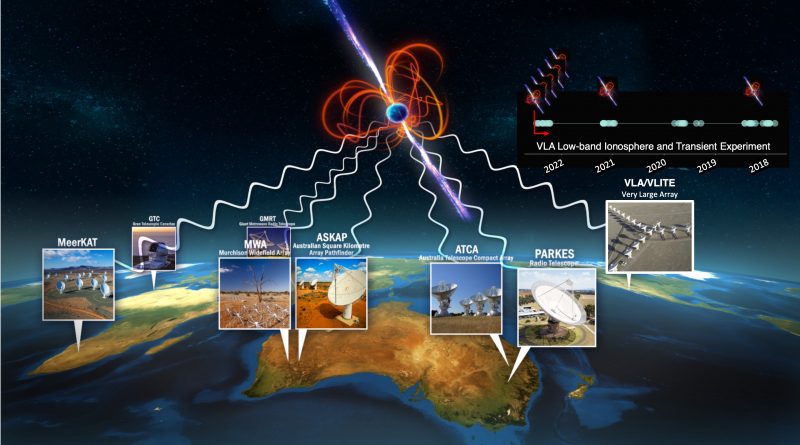NRL Astronomers Track New Stellar Phenomenon
The U.S. Naval Research Laboratory’s Very Large Array (VLA) Low-band Ionosphere and Transient Experiment (VLITE) telescope has helped astronomers confirm findings of a new stellar phenomenon that challenges current scientific understanding of the physics of neutron stars. The object is believed to be an ultra-long period magnetar, a rare type of star with powerful magnetic fields that can produce powerful bursts of energy, a finding that was published today in Nature.
NRL’s VLITE was developed in collaboration with the National Radio Astronomy Observatory in 2014. VLITE operates on the VLA as a stand-alone instrument for ionospheric and astrophysical studies. VLITE’s 18 antennas collect over 6000 hours of data per year, archived at NRL. Initially, it was implemented to constantly monitor the Earth’s ionosphere to study disturbances that can affect it, such as geomagnetic storms, seismic events, and gravity waves. This constant surveillance can detect transient blips, bursts of radio waves from cosmic sources that are elusive without continuous observation. Understanding these phenomena may lead astronomers to a better understanding of the Universe.
In September 2022, an international team of astronomers, led by Curtin University and the International Centre for Radio Astronomy Research (ICRAR) in Australia, discovered the stellar object (named GPM J1839-10) using the Murchison Widefield Array (MWA). The discovery set off an intense worldwide effort to understand GPM J1839-10. NRL astronomers quickly reprocessed stored VLITE data, identifying previously hidden emissions from the stellar object. Armed with the VLITE results, astronomers scoured archives and traced the emission from the source back more than three decades, to 1988.
“This enigmatic object has been hiding in the data for decades – we just did not know we had to look for it until its discovery by the MWA,” said Dr. Simona Giacintucci, NRL Research Astronomer. GPM J1839-10 emits a five-minute pulse of radio wavelength emission every 22 minutes, and it’s been doing this for at least 33 years.
“Findings like this are exciting because they highlight the gaps in our understanding of the physics of these extreme stars known as magnetars,” said Dr. Tracy Clarke, NRL Research Astronomer, and VLITE Project Scientist. “Current understanding says this object should not emit radio waves, yet we are detecting them across several decades and are not sure why. That is an exciting mystery.”
Astronomers believe GPM J1839−10 is a rare neutron star with extremely powerful magnetic fields. “Astronomy is one of those bizarre professions where we cannot go to our objects to study them,” Clarke said. “We are interested in how many of these are and where they are. That is directing future research.”
VLITE has exceeded its original mission fulfilling initial hopes of making discoveries like this. NRL astronomers will continue searching data sets produced with VLITE to lead future discoveries and a better understanding of the Universe with its fascinating objects. NRL’s instrumentation and cutting-edge research support the mission of the Navy and Department of Defense while continuing to contribute to science worldwide.

